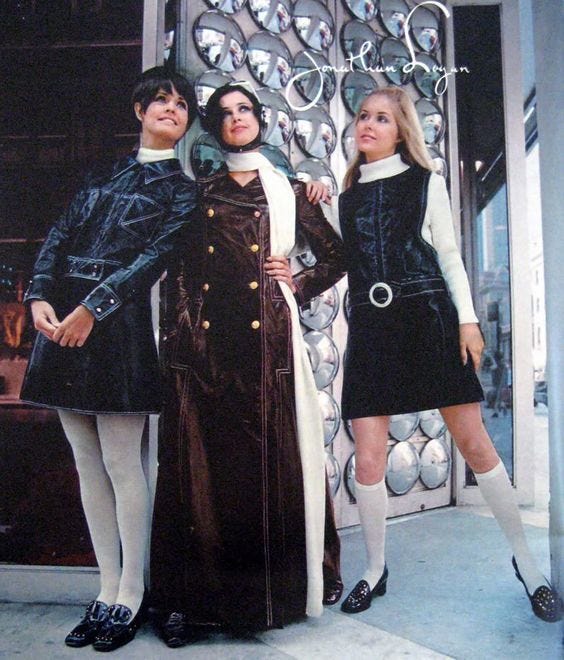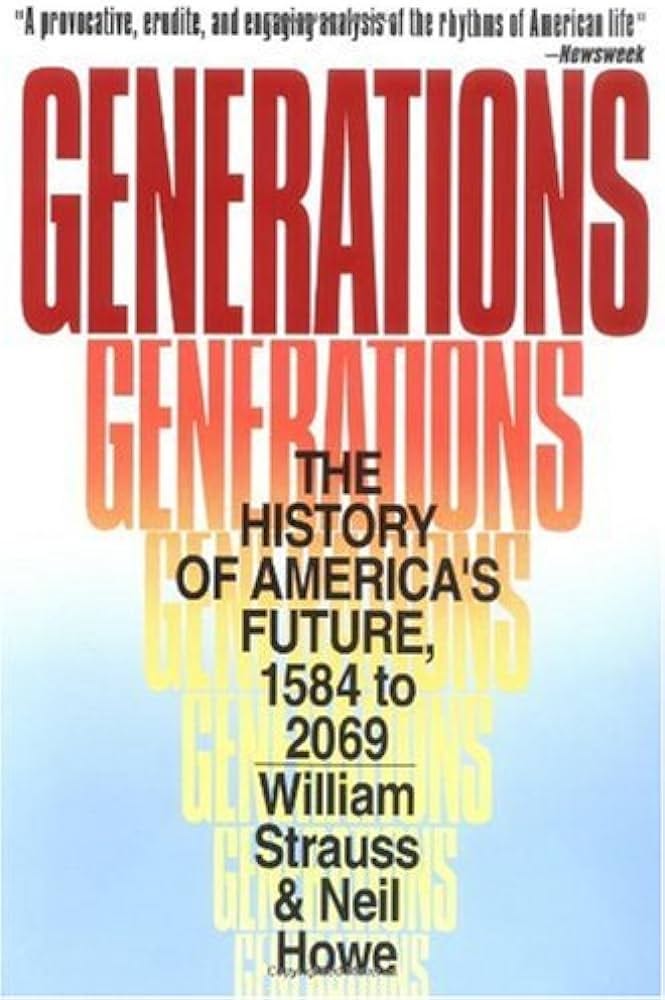*record scratches. The Youth by MGMT starts playing.* It’s easy to forget that Boomers were once young, curious, rebellious spirits. Inspired by a recent article I read (a TikTok I watched) on generational archetypes, a current obsession with Betsey Johnson, and a perpetual fascination with youth subcultures and countercultures, let’s talk about the original Youthquake and contemplate the future (AHHHH) as we witness the inception of the generational cycle anew with Gen Alpha.
60s Youthquake
In 1965, Diana Vreeland, the Editor-in-Chief of Vogue, coined the term "Youthquake" to capture the cultural shift of the 1960s, highlighting how music and pop culture reshaped the landscape of the fashion industry. This movement was marked by seeking style inspiration from youth culture and removing the influence of English and Parisian fashion houses of the time, like Dior and Chanel. This also marked the beginning of the ready-to-wear industry.
This era of social change fueled a spirit of rebellion and self-expression, with young people seeking to break away from the conventions of the 1950s. In England, a bored youth turned away from conservative couture designs, fueling a boutique movement that reshaped fashion with a modern approach. The boutique movement, led by figures like Mary Quant who is credited with inventing the mini-skirt, not only challenged traditional designs but also democratized fashion through mass production. These boutiques, like Biba and Bazaar in London and Paraphernalia in New York, displayed clothes like art in a gallery and embraced a lifestyle that celebrated individualism.
Amidst the backdrop of the Civil Rights Movement, anti-war protests, and the rise of counterculture, the "baby boomer" generation challenged societal norms as it entered adulthood. The resulting fashion trends of the youthquake era, including miniskirts, jumpsuits, and bold A-line silhouettes, became symbols of the era's fun, spirited, and youthful ethos. The Space Age trend, with experimentation in industrial materials, popularized androgynous shapes, form experimentation, metallic colors, and the use of lamé. A trend that has circled back around many times since, most recently with the American Apparel lamé tights and now with the metallics trend. We also witnessed the emergence of psychedelic fashion, inspired by artists like Jimi Hendrix, the (problematic) beginnings of boho-chic which took from Native American styles, and the contributions of Angela Davis and the Black Panthers to the era's fashion with her afro and utilitarian clothing. Davis's style reflected a powerful statement of purpose and resistance against societal injustices.
Another lingering remnant of the ‘60s youthquake is the use of pop culture icons in fashion advertising, for example, Edie Sedgwick as Betsey Johnson’s in-house model. This set a new precedent for marketing in the 21st century. In haute couture, luxury designers like Andrè Courrèges and Yves Saint Laurent appropriated youthquake influences into their collections, introducing mini-skirts and bold graphic silhouettes.
Generational Archetypes
In 1991, William Strauss and Neil Howe published "Generations: The History of America's Future, 1584 to 2069," a book on generational theory, and identified four archetypal generation types. These archetypes are part of a broader theory that suggests that history and social change are driven by recurring generational cycles. (Enter a new form of corporate/academic astrology. I’m sure there’s an astrological explanation for these archetypes and from what I’ve read the sign Pluto is in can define a generational archetype, but I don’t feel knowledgeable enough in astrology yet to work off of astrology-based theories, and I have no problem toying around with Strauss’ theory that is probably stolen from astrology anyway.)
According to Strauss-Howe, the first archetype is the Prophet Generation, most recently represented by Baby Boomers, who are idealistic and values-driven. Generation X embodies the Nomad archetype, characterized by pragmatism and adaptability. Millennials, as the Hero Generation, are civic-minded and institution builders. Lastly, Generation Z is seen as the Artist Generation, emphasizing individualism and creativity.
These archetypes are associated with specific periods of history and are said to repeat in a cyclical pattern. Each archetype responds to the challenges and opportunities of its time in distinct ways, shaping the course of history and culture. I think it goes without saying, that individual experiences within a generation can vary widely.
The next Prophet generation then, would be Gen-Alpha. Boomer fashion rebelled against the conservatism of the previous generation. In comparison, Gen Alpha, who’s still very young (possibly unborn) and developing their personal style, could pioneer fashion that rebels against the norms of the 2020s.
Yesterday’s, Today’s, & Tomorrow’s Youthquake
Youthquake, while initially labeled during the 60s, transcends both its origins and temporal boundaries. Similar style movements have manifested in various decades because Youthquake is essentially about the youth figuring themselves out, and rebelling. There are always going to be young people who hate what older people have created. Think of the flapper aesthetic in the 20s, rock and roll and punk in the 70s and 80s, grunge and heroin-chic in the 90s, and the flashy McBling and alternative Indie Sleaze of the 2000s. Right now, we’re witnessing the dissolution of rigid aesthetic norms and giving way to a fashion landscape where individuality reigns supreme. Today’s zeitgeist embraces everything, everywhere, all at once, as shown by the resurgence of DIY/upcycle culture and the pursuit of "discovering your personal style."
Growing up in an era of unprecedented technological advancement, Gen Z and Gen Alpha are crafting style identities based heavily on their online existences and dissatisfaction with the entrenched structures of our political and social systems. It might be a little soon to guess what Gen Alpha will be wearing in ten to twenty years, but at least right now our style reflects a fusion between being chronically online and nostalgic for the tangible elements of the past. As the digital and physical worlds continue to intertwine, Gen Alpha's fashion journey promises to be a reflection of its evolving worldview.
Touching back on the astrological undertones of this entire post, I think the spiritual awakening we’re living through now will also have an impact on the Prophet Generations Youthquake. The Youthquake era and Boomer fashion of the 1960s were influenced by various spiritual and philosophical movements. This era saw a surge in interest in Eastern mysticism, transcendental meditation, and psychedelic experiences. The exploration of spirituality was intertwined with the rejection of traditional values, societal norms, and the pursuit of individual expression. The blending of technology and spirituality might manifest in clothing choices that embody a desire for harmony with the digital and spiritual realms.
The impact of technology on fashion consumption is evident with online platforms and e-commerce reshaping the way trends are discovered, shared, and consumed. Social media platforms are the most influential spaces for shaping fashion trends. Today’s influencers and content creators play a role analogous to that of artists, musicians, and “it” girls of the past. Today, Youthquake approaches its zenith as young people utilize social media as a channel to exert the greatest influence they've ever had.
If the Youthquake of the 1960s symbolized a shift of power away from established fashion houses, today's Youthquake marks a departure from the influence of fast fashion, a phenomenon born out of the Boomer generation's stylistic rebellion. Gen Z’s and Gen Alpha’s rebellion is expressed through unconventional fashion choices but also in a broader rejection of traditional modes of learning, socializing, and consumption. The pillars of today’s Youthquake rest on three key principles: technology, sustainability, and self-expression. The influence is not just in what we wear but also in how fashion is produced and how we engage with the concept of "circular fashion."
The youth are starting to change. Are you starting to change? Are you together, together, together, together, together, together, together?
Sources
https://www.lifecourse.com/about/method/generational-archetypes.html
https://www.fitnyc.edu/museum/exhibitions/youthquake.php
https://aboutgenerations.com/articles/fashion-trends-throughout-the-generations/









